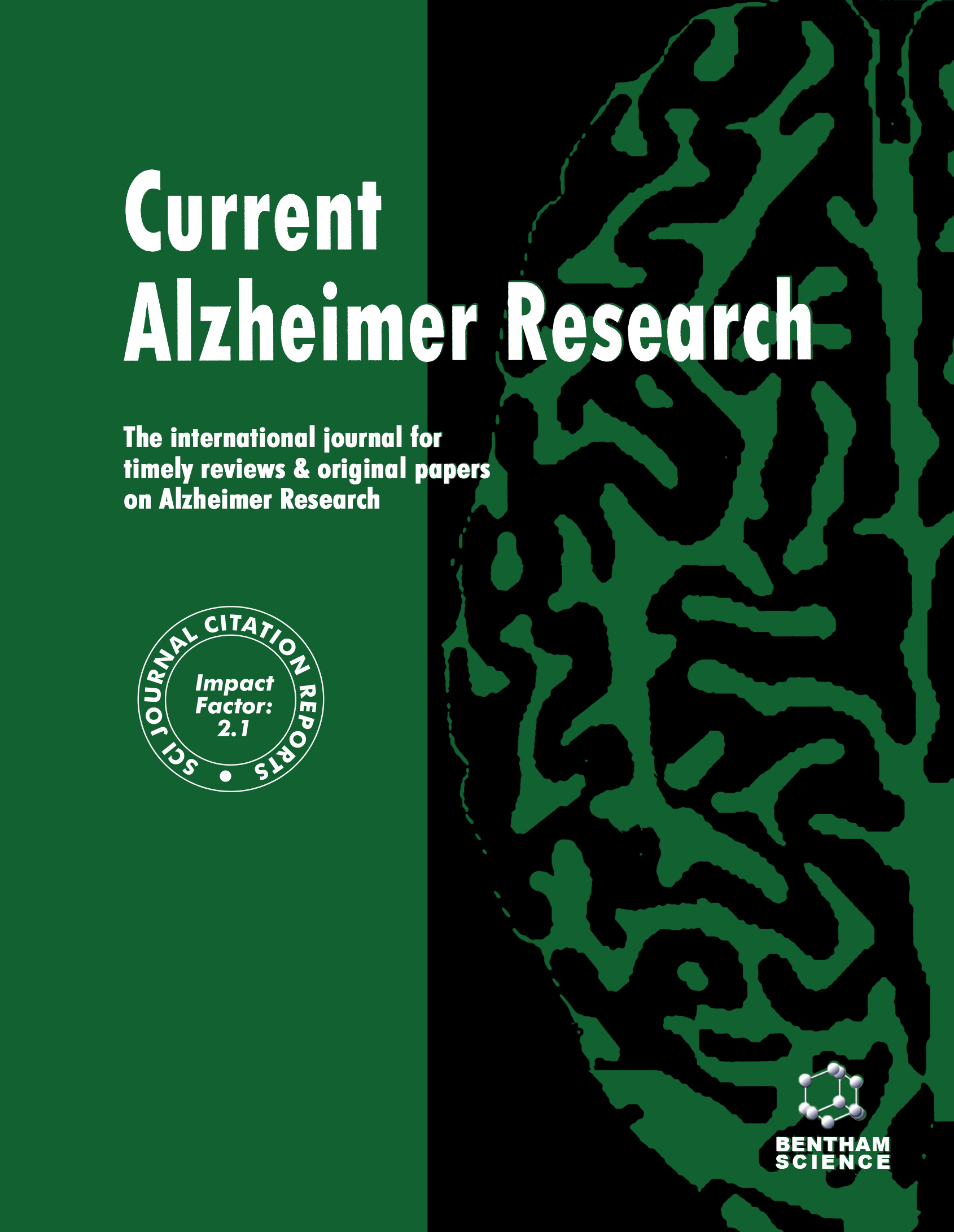- Home
- A-Z Publications
- Current Alzheimer Research
- Previous Issues
- Volume 17, Issue 7, 2020
Current Alzheimer Research - Volume 17, Issue 7, 2020
Volume 17, Issue 7, 2020
-
-
A Cationic Gallium Phthalocyanine Inhibits Amyloid β Peptide Fibril Formation
More LessBackground: Amyloid β (Aβ) peptide deposition is considered as the main cause of Alzheimer’s disease (AD). Previously, we have shown that a Zn containing neutral phthalocyanine (Zn-Pc) inhibits Aβ fibril formation. Objective: The objective of this study is to investigate the effects of a cationic gallium containing Pc (GaCl-Pc) on Aβ fibril formation process. Methods and Result: Aβ fibril formation was induced by incubating synthet Read More
-
-
-
Investigation of Low Dose Cabazitaxel Potential as Microtubule Stabilizer in Experimental Model of Alzheimer's Disease: Restoring Neuronal Cytoskeleton
More LessAuthors: Pallavi Duggal, Kuldeep S. Jadaun, Ehraz M. Siqqiqui and Sidharth MehanBackground: Neuronal Microtubule (MT) tau protein, providing cytoskeleton to neuronal cells, plays a vital role, including maintenance of cell shape, intracellular transport, and cell division. Tau hyperphosphorylation mediated MT destabilization results in axonopathy, additionally neurotransmitter deficit and ultimately causing Alzheimer's disease. Pre-clinically, streptozotocin (3mg/kg, 10μl/ unilateral, ICV) stereotaxically mimics the Read More
-
-
-
Alterations in Mitochondrial Dynamic-related Genes in the Peripheral Blood of Alzheimer’s Disease Patients
More LessBackground: Mitochondrial dysfunction is a pathological feature that manifests early in the brains of patients with Alzheimer’s Disease (AD). The disruption of mitochondrial dynamics contributes to mitochondrial morphological and functional impairments. Our previous study demonstrated that the expression of genes involved in amyloid beta generation was altered in the peripheral blood of AD patients. Objective: The aim Read More
-
-
-
Hypoxic Preconditioning Ameliorates Amyloid-β Pathology and Longterm Cognitive Decline in AβPP/PS1 Transgenic Mice
More LessAuthors: Jian Zhang, Ji Zhang, Xiao-Jia Li, Jun Xiao and Fang YeBackground and Objective: Hypoxic Preconditioning (HPC) has been well established to trigger endogenous mechanisms of neuroprotection basing on models of hypoxic and ischemic diseases in the Central Nervous System (CNS). However, its effects against Alzheimer's Disease (AD) still lack substantial evidence and in-depth exploration. The present study aimed to investigate the impacts of HPC on AD-related memory declin Read More
-
-
-
Modelling Decline in Cognition to Decline in Function in Alzheimer’s Disease
More LessObjectives: The study aimed to evaluate and quantify the temporal link between cognitive and functional decline, and assess the impact of the apolipoprotein E4 (APOE-e4) genotype on Alzheimer’s disease (AD) progression. Methods: A nonlinear mixed-effects Emax model was developed using longitudinal data from 659 patients with dementia due to AD sourced from the Alzheimer's disease neuroimaging initiative (ADNI) Read More
-
-
-
Automatic Assessment of Cognitive Tests for Differentiating Mild Cognitive Impairment: A Proof of Concept Study of the Digit Span Task
More LessAuthors: Meysam Asgari, Robert Gale, Katherine Wild, Hiroko Dodge and Jeffrey KayeBackground: Current conventional cognitive assessments are limited in their efficiency and sensitivity, often relying on a single score such as the total correct items. Typically, multiple features of response go uncaptured. Objectives: We aim to explore a new set of automatically derived features from the Digit Span (DS) task that address some of the drawbacks in the conventional scoring and are also useful for distinguis Read More
-
-
-
The Association between Polygenic Hazard and Markers of Alzheimer’s Disease Following Stratification for APOE Genotype
More LessBackground: Research indicates that polygenic indices of risk of Alzheimer’s disease are linked to clinical profiles. Objective: Given the “genetic centrality” of the APOE gene, we tested whether this held true for both APOE-ε4 carriers and non-carriers. Methods: A polygenic hazard score (PHS) was extracted from 784 non-demented participants recruited in the Alzheimer’s Disease Neuroimaging Initiative and stratified by APOE Read More
-
-
-
Impaired Cognitive Function is Associated with Motor Function and Activities of Daily Living in Mild to Moderate Alzheimer's Dementia
More LessBy GyuChang LeeBackground: The deterioration of cognitive and motor functions and activities of daily living is common in Alzheimer's dementia. Objectives: The purpose of this study was to investigate the correlation and the strength of the relationship between cognitive function and motor function and activities of daily living after a diagnosis of Alzheimer's disease dementia. Methods: Sixty-three patients with mild to moderate Alzheimer Read More
-
Volumes & issues
-
Volume 21 (2024)
-
Volume 20 (2023)
-
Volume 19 (2022)
-
Volume 18 (2021)
-
Volume 17 (2020)
-
Volume 16 (2019)
-
Volume 15 (2018)
-
Volume 14 (2017)
-
Volume 13 (2016)
-
Volume 12 (2015)
-
Volume 11 (2014)
-
Volume 10 (2013)
-
Volume 9 (2012)
-
Volume 8 (2011)
-
Volume 7 (2010)
-
Volume 6 (2009)
-
Volume 5 (2008)
-
Volume 4 (2007)
-
Volume 3 (2006)
-
Volume 2 (2005)
-
Volume 1 (2004)
Most Read This Month
Article
content/journals/car
Journal
10
5
false
en

Most Cited Most Cited RSS feed
-
-
Cognitive Reserve in Aging
Authors: A. M. Tucker and Y. Stern
-
- More Less

